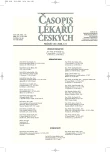-
Medical journals
- Career
Faecal Elastase I. Assessment – Its Use in Diagnosis of Chronic Pancreatitis
Authors: T. Krechler; P. Kocna 1; Z. Vaníčková 1; T. Švestka; M. Lukáš; J. Doseděl 2; P. Kohout 3; A. Žák
Authors‘ workplace: IV. interní klinika 1. LF UK a VFN, Praha ; Ústav klinické biochemie a laboratorní diagnostiky 1. LF UK, Praha 1; Nemocnice U Milosrdných sester sv. Karla Boromejského, Praha 2; Fakultní Thomayerova nemocnice 1. LF UK, Praha 3
Published in: Čas. Lék. čes. 2006; 145: 480-483
Category: Original Article
Overview
Background.
The diagnosis of chronic pancreatitis is based on the imaging methods. These imaging methods show the main morphological changes in the pancreatic ducts and its parenchyma, but they do not define the function of the pancreas. The aim of our study was Faecal Elastase I. determination in patients with chronic pancreatitis. The test is a simple, non-invasive method of the investigation of the pancreatic exocrine insufficiency. The Faecal Elastase I occurring in the stool was correlated with the level of the damage of pancreatic tissue together with the control group of the patients with different diagnoses.Methods and Results.
Faecal Elastase I (mean values in ug/g of stool) detection is a simple, non-invasive method which correlates well with the damage of pancreatic tissue, stemming from chronic pancreatitis. This test is routinely used especially in the diagnosis of chronic pancreatitis. The classification of chronic pancreatitis currently depends on the morphological changes of the pancreatic duct system (the patho-morphological changes). We are currently missing the classification describing simultaneously the morphological changes of the gland and the function of the pancreas. In our studies we have used a newly proposed classification system, which was put together in Bern, 2000 (1). This new system encompasses morphological and functional changes. Faecal Elastase I was determined by a microplate ELISA method using monoclonal antibody to human pancreatic protein. The Faecal Elastase I. was tested in the stool of the 196 patients with chronic pancreatitis stemming from alcoholism. The occurrence of Faecal Elastase I. was classified according to the levels assigned by the classification system. The control group used in this study included 144 patients with different diagnoses. The results demonstrate a very good correlation of Faecal Elastase I. with the grading of the newly proposed classification system of chronic pancreatitis. Patients with the highest levels of the damage of the pancreas had a significantly lower occurrence of Faecal Elastase I. in comparison with the non-pancreatic control group and in patients with chronic pancreatitis who had no clinical complications or damage of endocrine and exocrine functions of the pancreas.Conclusions.
Feacal Elastase I performance plays an important role in diagnosing of the severe cases of chronic pancreatitis and in the follow-up of the chronic pancreatitis in the patients with the intermediate damage of the pancreas.Key words:
chronic pancreatitis, functional tests, Faecal Elastase I.
Labels
Addictology Allergology and clinical immunology Angiology Audiology Clinical biochemistry Dermatology & STDs Paediatric gastroenterology Paediatric surgery Paediatric cardiology Paediatric neurology Paediatric ENT Paediatric psychiatry Paediatric rheumatology Diabetology Pharmacy Vascular surgery Pain management Dental Hygienist
Article was published inJournal of Czech Physicians

-
All articles in this issue
- Meckel’s Diverticulum
- Capsule Endoscopy – The Past, Presence, and Future
- Prediction and Monitoring of Severe Acute Pancreatitis
- Fatty Liver Disease and Statins – Which Discipline the Problem Belongs To?
- Hyperamylasemia, Laboratory and Clinical Aspects
- Different Views on the Association between Cannabinoids and Cancer
- Injury of the Scapholunate Interosseal Ligament – Scapholunate Dissociation
- Changes in Serum and Adipose Tissue Fatty Acid Composition after Low Calorie Diet with Respect to Dietary Fat Content in Obese
- Changing Clinical Image of Celiac Sprue in Childhood
- Hereditary Forms of Colorectal Adenomatous Polyposis
- Faecal Elastase I. Assessment – Its Use in Diagnosis of Chronic Pancreatitis
- Evaluation of DHPLC Analysis for Mutation Detection in Haemophilia A
- Paraneoplastic Encephalitis
- Patient’s Human Dignity and the Health Care
- Risk of Alcohol Abuse in Adolescence
- Journal of Czech Physicians
- Journal archive
- Current issue
- Online only
- About the journal
Most read in this issue- Faecal Elastase I. Assessment – Its Use in Diagnosis of Chronic Pancreatitis
- Injury of the Scapholunate Interosseal Ligament – Scapholunate Dissociation
- Hyperamylasemia, Laboratory and Clinical Aspects
- Capsule Endoscopy – The Past, Presence, and Future
Login#ADS_BOTTOM_SCRIPTS#Forgotten passwordEnter the email address that you registered with. We will send you instructions on how to set a new password.
- Career

